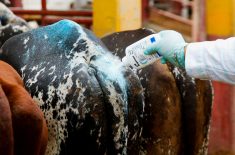Feeder cattle prices were steady to $2 lower in comparison to a week earlier. A mixed group of age-verified steers weighing 581 pounds sold for $166 per hundredweight in east central Alberta. Charolais-cross medium-flesh age-verified steers weighing 680 lbs. traded for $160 in the Picture Butte area. A larger group of heavy-flesh black and red Angus-cross age-verified 800-lb. feeder heifers sold for $128/cwt in central Manitoba. A large group of 825-lb. steers of black and red cross British age-verified heavier-flesh steers sold for $140/cwt, delivered Iron Springs, Alta. Backgrounding operators need to be careful how hard they make the cattle because larger discounts were shown this week on the “flesh” scale.
Read Also

U.S. grains: Soy futures post biggest monthly gain in nearly five years on China trade optimism
U.S. soybean futures climbed to a 15-month high and posted their biggest monthly gain in nearly five years on Friday following a rally fueled by the prospect of revived exports to China.
Live and feeder cattle futures came under pressure due to a new U.S. case of BSE — this coming on the heels of the “pink slime” debacle. Despite the negative media hype, wholesale values jumped $10/cwt and beef packing margins finished the week near break-even, the highest level since September.
Feed barley jumped $5, to $255/cwt delivered southern Alberta, while packers bought slaughter cattle at $110/cwt. Alberta feedlots are now realizing negative margins of over $100 per head. Feedlots continue to hold back on sales, with carcass weights are running 67 lbs. above year-ago levels. This environment has slowed purchases of replacement cattle. Grass cattle demand remains limited because the small-farmer cattle operator is seeding. Buyers held back earlier in spring due to high prices and many will bale the grass instead of taking the risk on cattle.












